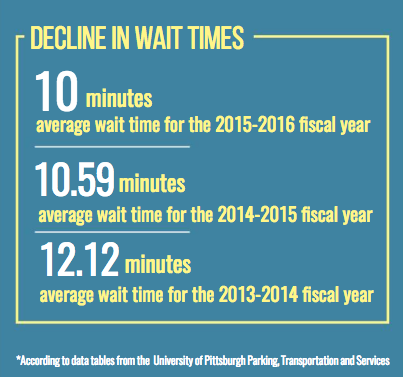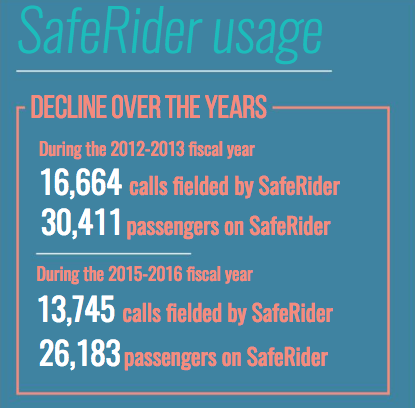Over the past four fiscal years, SafeRider usership has declined by nearly 18 percent, but an app proposal could persuade more riders to turn back to the transportation system in the future.
Kevin Sheehy, director of the University of Pittsburgh Parking, Transportation and Services, said the University is looking into upgrading SafeRider, in part by creating an app through which students can order a ride. He had no estimate of how long this would take but said in an email that the app could address student complaints about the University ride system.
“As we explore options involving an ‘app,’ we think that wait times can improve as well as the overall experience,” Sheehy said.
The reasons for the decline in ridership are not so clear. Some students complain that SafeRider’s inefficiencies — such as long wait times and rigid guidelines about their routes — have deterred them from using the service. Others feel misguided after finding out that the service has limitations on where students can be picked up and dropped off.
Jordan Johnson, a senior linguistics major, said she didn’t utilize all 20 of SafeRider’s allotted rides because she was not satisfied with the service. In her sophomore year, Johnson frequented the Centre Plaza Apartments — on-campus housing about 0.8 miles from the Cathedral of Learning — because her friends lived there.
Johnson said she called to get a SafeRider on multiple occasions around 11 p.m. or 12 a.m. from the Centre Plaza Apartments because she didn’t feel comfortable waiting on Centre Avenue outside of the apartments for the bus — which could take 20 minutes to arrive.
But the SafeRider phone operators told her to take a fixed-route bus since she was near a stop and the buses were running, so sometimes she would just walk home.
“[I] would text four of my friends and be like, ‘Hey, I’m walking home right now. If you don’t hear from me in an hour, I’m dead. Call me,’” Johnson said.
SafeRider is designed to help students, faculty and staff for non-emergency situations when a fixed route shuttle — such as the 10A — is not available, according to Sheehy. The service runs from 7 p.m. to 3 a.m. Sunday through Wednesday and until 5 a.m. Thursday through Saturday.
Students can take up to 20 rides on SafeRider per semester.
Friday and Saturday are SafeRider’s busiest nights, and it schedules three vehicles during this time instead of the normal two. SafeRider service boundaries are Baum Boulevard to the north, Carnegie Mellon University to the east, the Center for Biotechnology and Bioengineering to the south and Trees Hall and Robinson Street to the west, according to the University website.
SafeRider usership fluctuates often, but the past four years have seen a decline in the total number of calls and passengers. During the 2012-2013 fiscal year — July until the following June –– SafeRider fielded a total of 16,664 calls. This number decreased to 13,745 calls in the 2015-2016 year, a nearly 18 percent drop, according to data tables from the University of Pittsburgh Parking, Transportation and Services.
In that same period, there was a 14 percent drop in recorded passengers.
A saferider system is especially useful in a city without high rates of taxi service, but the surging popularity of rideshare apps, like Uber and Lyft, has replaced the need for both.
Some schools, such as the University of Southern California, have partnerships with Uber to address inefficiencies in their own campus transportation systems. According to USC’s website, the university pays for eligible Uber rides within campus when wait times for its Campus Cruiser are longer than 15 minutes.
Sheehy said the University has approached Uber and has “been in talks, gathering information in regards to what they can bring to the table.”
“There are always legalities involved when moving into a partnership. The number one concern is safety,” Sheehy said. “Before we partner with an organization, we have to investigate all the ins and outs regarding the whole process and other safety precautions.”
Gavi Stein, a junior applied developmental psychology major, calls SafeRider her “personal Uber.” She first rode at the end of last year, and after that, she said she began to call SafeRider weekly. But there are still times when she picks the rideshare company over Pitt’s service.
“If I was by myself on the side of the street I would call an Uber before I called a SafeRider just because SafeRider would take so long,” Stein said.
According to data from the University of Pittsburgh Parking, Transportation and Services, the average wait time for the 2015-2016 fiscal year was just over 10 minutes, which is lower than in previous years. For the 2014-2015 fiscal year, the average wait time was just under 11 minutes. For 2013-2014, it was just over 12 minutes.
Sheehy said that during the peak times between 11 p.m. to 2 a.m., the wait time can be longer, and wait times can be affected when students do not show up.
A no-show adds an average of 15 to 20 minutes wait time to the next pick up, and students calling for rides to or from fixed-route locations can also increase wait time, Sheehy said.

Even though Stein admits that the service is not always timely, she said it doesn’t bother her.
“Sometimes I’ve been on hold with them for like two minutes, and sometimes it’s been like 30 minutes. I don’t really mind,” Stein said. “I understand that they’re dealing with a ton of people at one time … [If there was an app], I would probably use [SafeRider] more often, and I use it super often.”
Although students do not pay for rides individually, SafeRider is funded by the $90 transportation fee each student pays per semester. The fee also covers other campus shuttles; the Port Authority of Allegheny County Fare-Free Program, which allows students to use PAT buses free of charge and other safety and security features on campus.
Ryan Scandaglia, a senior English writing major and Pitt Pathfinder, said in tours SafeRider is presented as a no-questions-asked shuttle for students to use if they feel unsafe. However, Scandaglia said that since the information about SafeRider is so specific, he often does not mention that it is not for transportation to stops on the fixed bus routes.
“Pathfinders can’t say everything we are supposed to, you know?” Scandaglia said. “Our tour would be three hours long. You say what you think is best, based generally on our tour script.”
On one occasion, after the SafeRider operator told Johnson to take the fixed-route bus, again at the Centre Plaza Apartments, Johnson asked if a SafeRider would pick her up at an intersection one block away. The operator responded that he or she would send a vehicle.
“What’s the difference between me feeling unsafe a block away?” Johnson said. “A block different?”


